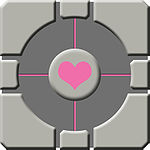Alamo (sculpture)

|
| Alamo |
|---|
| Bernard Rosenthal , 1967 |
|
Bronze , 2400 cm × 2400 cm × 2400 cm |
| Astor Place ; Manhattan , New York City |
Alamo (also: Astor Place Cube or " The Cube ") is an open-air sculpture by Bernhard Rosenthal , which is installed on Astor Place , New York City . Alamo is a black iron - Dice (ger .: Cube ) with an edge length of 2.4 meters, 820 kg heavy, standing on a corner. The surface is not smooth, but has various indentations, protrusions and edges. The name was chosen by Rosenthal's wife and is explained on a small plaque: the dimensions and size reminded her of the historic Fort Alamo . The cube can be rotated by hand about its vertical axis.
history
The work of art is one of five identical cubes by Rosenthal, the copy at Astor Place was created in 1967 as part of the organization " Sculpture and the Environment " (German: "Sculptures and their environment") by the municipal culture committee ( Department of Cultural Affairs ) along with 24 others Works set up. Originally, the installations were only supposed to stay on site for six months, but the residents obtained a permanent installation in the East Village with a petition . In 2005, at NYC Parks' efforts, an extensive renovation was carried out by the artist and his original employees, during which the so-called “ Jello Cube ” was temporarily installed at the installation site in memory of Peter Cooper .
Pranks
The Alamo has been targeted and victim of pranks several times:
- In June 2004, the look of a Rubik's Cube was glued on with colored cardboard . The campaign by the group All Too Flat (German: “Everything too flat”) lasted more than 24 hours.
- In March 2006, the Graffiti Research Lab distributed magnetic, battery-operated LEDs (so-called LED throwies ) that gave the black cube a colorful decoration.
- In April 2006 a pack of chalk was deposited on the cube and passers-by began to paint it. The next morning the cube was washed and a total of seven people were arrested for public vandalism .
- In October 2011 the artist Olek (Agata Oleksiak) crocheted a throw with a camouflage pattern.
- In December 2011, students from Caltech University covered the cube with cloth to give it the appearance of an object from the computer game Portal .
- In 2013, a pseudo-documentary spread on the Internet in which a man claimed to live in the Alamo. In addition to various sequences, the video also shows an interior that seems to correspond to the real cube. The originator of the hoax is a "company about nothing" (Original: Brand about nothing ), which wants to promote its 60-second meditation technique against burnout .
"This video is fictional. It is not possible to gain entry to the interior of this cube. (German: The video is fiction. It is not possible to enter the interior. ) "
Web links
- tonyrosenthal.com - website of the artist
- Man in a cube on YouTube - The hoax that was widespread in 2013.
Individual evidence
- ^ Colin Moynihan: The Cube, Restored, Is Back and Turning at Astor Place ( en ) The New York Times . November 19, 2005. Retrieved October 6, 2013.
- ^ Astor Cube . In: All Too Flat . Archived from the original on July 21, 2010. Retrieved July 17, 2010.
- ↑ LED Throwies II . In: Graffiti Research Lab . Archived from the original on July 10, 2010. Retrieved July 17, 2010.
- ↑ Jake Dobkin: Astor Cube Attacked with Chalk (en) . In: Gothamist , April 2, 2006. Retrieved 2010-17-17.
- ^ Street artist Olek hits Astor Place in New York City . YouTube. Retrieved December 24, 2011.
- ↑ Garth Johnston: Photos: CalTech Prank Club Blankets The Astor Place Cube ( en ) In: Gothamist . December 14, 2011. Retrieved December 14, 2011.
- ↑ Christine Erickson: Sorry, No One Is Living in the Astor Place Cube ( en ) In: Mashable . October 6, 2013. Retrieved October 6, 2013.
